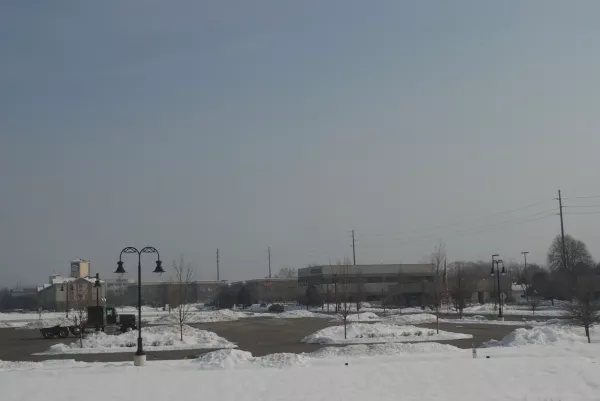Clearing the Air
Cleaning the state's air will take a helping hand from every breathing Utahn
By Colby Frazier @colbyfrazierlpAveraged out over a year, Utahns are exposed to a daily dose of 11 micrograms per cubic meter of PM 2.5—a level of pollution that will chop a year off our lives, according to C. Arden Pope, an environmental economist at Brigham Young University who has for decades studied the impacts of air pollution on health.
Pope says that although this level of exposure isn’t as high as in other parts of the world, it is serious and can now be quantified in the number of years pollution steals from us.
And barring a lottery-like miracle, the bad-air equation in Utah isn’t likely to improve now, or perhaps even ever, unless cars stop driving, people stop heating their homes and the market forces that fuel Kennecott and other major polluters seize.
But Utah regulators hope to see air on the Wasatch Front fit to breathe, at least by federal Clean Air Act standards, by 2019—a six-year time frame that many clean-air advocates say is overly optimistic.
On Jan. 8, the state’s Division of Air Quality Board is expected to approve the second piece of its state implementation plan (SIP), a blueprint of sorts that outlines how Utah intends to bring its fouled air into compliance with federal health standards.
The plan will unleash scores of regulations for the state’s industrial polluters, but it still allows a 12 percent increase over the next six years in the level of tiny particulate pollution, or PM 2.5, that these businesses will spew.
Meanwhile, as the state’s population continues its boom, more cars will hit the road, and more homes will be built, contributing greatly to what regulators say are the two largest sources of pollution in the Salt Lake Valley: homes and cars.
By the time these words see ink, most of the state’s population will be living beneath a toxic soup of pollution that politicians and environmental activists agree is caused by every single person, car, home and business here. Yet, fingers will continue to be pointed and accusations made about those who are responsible—a winless contest since this pollution, and this air, belongs to everyone.
“People focus on the industrial sources because that’s the one that’s easiest to point the finger at,” says Dave McNeill, manager of the planning branch for the state’s Division of Air Quality. “[We’re] trying to teach people that they’re causing the problem and what to do to teach them to take personal responsibility for it.”
Matt Pacenza, the policy director at HEAL Utah, says that although individuals clearly need to do more, his organization, and many others, believe that the DAQ is not doing all it can to chop pollution from large industrial sources.
“The path forward is clear, but it’s going to cost significant resources, and those resources can only come if our political leaders make tough choices about revenue,” he says.
To that end, a number of efforts are afoot, in the legislature and elsewhere, to rein in Utah’s air-pollution quandary.
The public seems to be united, across political and religious lines, in its desire to have clean air to breathe. According to a survey by Envision Utah, a group that studies sustainable growth for the state, 99 percent of Utahns are willing to take personal action to improve air quality.
The largest contributor to the area’s pollution, McNeill says, is vehicles. And in Salt Lake County, cutting 2014’s anticipated 31.7 million vehicle miles per day—which pumps 1.8 tons of PM 2.5 into the air—could go a long way toward cleaning the air.
But getting folks out of their cars isn’t easy, especially when the Utah Transit Authority, at $2.50 for base fare, ranks among the priciest public transit systems in the country. Add to this cutbacks to bus service to help finance UTA’s $2.3 billion rail expansions and recession-related decreases in sales-tax revenues—which, according to a Utah legislative audit, accounts for the vast majority of its budget—and the state ends up with a transit system that is costly and oftentimes inconvenient.
Salt Lake City will attempt to have tackled the price issue by February. Its new resident transit passes will cost $30 per month, $54 cheaper than the current monthly adult pass.
Remi Barron, a UTA spokesman, says the success of the program will hinge on its numbers. In order for UTA to break even, Salt Lake City must sell 6,500 of these passes—a number city officials believe they’ll easily reach.
State Rep. Joel Briscoe, D-Salt Lake City, intends to introduce legislation this year that would raise the cap on sales taxes that can be funneled to public transportation. Briscoe says increasing this sum to 1 cent—up from about seven-tenths of a cent in Salt Lake County, and much lower in other areas—is critical to bolstering bus service and helping to drop fare prices.
“It’s great that we make cars cleaner, but we just need to have a better support system by getting them out of cars,” Briscoe says. “That’s the great need I see right now.”
On another front, Erin Mendenhall, Salt Lake City’s 5th District city council member-elect—who is also the executive director of Breathe Utah, a nonprofit that advocates for clean air—has zeroed in on some of the more than 200 homes registered with the Division of Air Quality that rely solely on wood-burning stoves for heat.
The consequences of wood burning have recently come into focus. According to a study by Kerry Kelly, a University of Utah chemical engineer who also sits on the Utah Air Quality Board, using a wood stove for one hour produces the same amount of PM 2.5 as driving 1,150 miles. The study also shows that heating with a wood stove puts out the same amount of pollution as 90,000 homes using natural gas.
With a $25,000 grant, Breathe Utah aims to replace wood-burning stoves in five of these homes with natural-gas stoves—a small, but doable task to improve air quality.
“The public doesn’t yet understand the gravity and disproportionate nature of our fireplaces affecting our airshed,” Mendenhall says. “It’s an extremely disproportionate source of pollution.”
As residents wait for these changes, it’s clear that regulators and scientists have only recently come to fully understand PM 2.5 and its health impacts. McNeill points out that the state’s SIP has as its backbone standards that the EPA set forward in the 1990s to deal with a larger type of pollution known as PM 10. “When [the Clean Air Act] was written, there was no such thing as PM 2.5,” he says.
And only a decade has passed since academics like BYU’s Pope discovered that PM 2.5 is not only harmful to respiratory function, but that it imbeds deeply in the lungs and also causes damage to the cardiovascular system, which can lead to heart disease.
“It’s not just some optical illusion,” Pope says of Utah’s pollution. “Our understanding of its impacts on our health has improved. It’s become more prominent in the way we evaluate its impact on our lives. I think that’s important, that when we have our nasty air, it’s just that: It’s nasty air that is unhealthy.”
More by Colby Frazier
-
Fire Line
UFA Board considers recouping bonuses paid to former chiefs and turning investigation over to law enforcement.
- Jan 25, 2017
-
Home Sweet Home?
How a single real estate deal highlights a city in flux and in crisis.
- Jan 4, 2017
-
Dead Red
That Utah could end up voting something other than Republican proved delusional.
- Nov 9, 2016
- More »
Latest in News
Readers also liked…
-
Raise a glass for E.L.T Harrison, architect of the Beerhive building on Main
Small Lake City
- Oct 11, 2023





